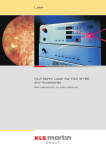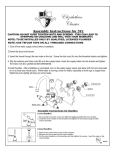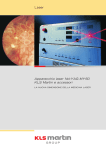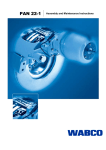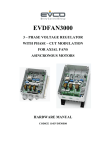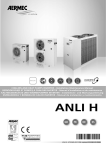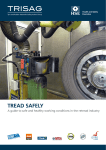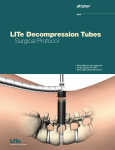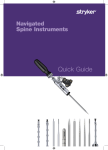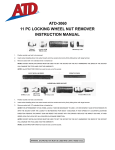Download Surgical technique
Transcript
Retractor Kit Rev: D Instruction For Use NEXT ORTHOSURGICAL 3270 CORPORATE VIEW, SUITE A VISTA CA 92081 8/1/14 Retractor Kit Rev: D Summary 1. User manual ................................................................................................................ 3 1.1. 2. 1.1.1. Destination .................................................................................................... 3 1.1.2. Surgical context .............................................................................................. 3 1.1.3. Description..................................................................................................... 4 1.2. Convenience kit content ......................................................................................... 4 1.3. Handling instructions .............................................................................................. 4 1.3.1. General ......................................................................................................... 4 1.3.2. K-wire and K-wire handle ................................................................................. 5 1.3.3. Dilators, dilator holder and probe ...................................................................... 5 1.3.4. Retractor, blades and wrench ........................................................................... 7 1.3.5. Table clamp (use for mobile and static position) ................................................ 10 1.3.6. Disposable light mats and extension cords ........................................................ 12 1.3.7. Light cable and light holder ............................................................................. 13 1.3.8. Shim, broach and shim/broach holder .............................................................. 14 1.3.9. Optional blade extension ................................................................................. 15 1.3.10. Optional 4th blade and its support ................................................................. 16 1.3.11. Container .................................................................................................. 17 Instructions for cleaning, sterilization and maintenance .................................................... 18 2.1. Handling prior to cleaning ...................................................................................... 18 2.1.1. Disassembling of the retractor ......................................................................... 18 2.1.2. Shim/broach holder disassembling ................................................................... 20 2.1.3. 4th blade support special handling care ............................................................. 20 2.1.4. Dilators holder special handling care................................................................. 21 2.1.5. Table clamp base special handling care ............................................................. 21 2.2. 3. Presentation .......................................................................................................... 3 Cleaning – decontamination ................................................................................... 22 2.2.1. Preparation for cleaning .................................................................................. 22 2.2.2. Manual Cleaning ............................................................................................ 22 2.2.3. Automatic Cleaning ........................................................................................ 22 2.3. Sterilization.......................................................................................................... 23 2.4. Storage ............................................................................................................... 24 2.5. Maintenance......................................................................................................... 25 2.5.1. Retractor ...................................................................................................... 25 2.5.2. Table clamp connector .................................................................................... 25 2.5.3. 4th blade support ........................................................................................... 26 2.5.4. Shim holder .................................................................................................. 26 2.6. Complaints........................................................................................................... 27 2.7. Contact ............................................................................................................... 27 Chart of medical device symbols used ............................................................................ 27 Retractor Kit Rev: D USER MANUAL 1. User manual 1.1. Presentation 1.1.1. Destination This kit is composed of several instruments which will be used by a trained orthopedic surgeon or neuro-surgeon to create a lateral or posterior access to the spine. This kit is used to provide a spinal access channel through the tissue. The retractor will move apart the flesh to allow the surgeon access to the disk or at the wound bottom. 1.1.2. Surgical context Probes and light mats are sterile single-use products. Other instruments of the kit are reusable. Sterile/Nonsterile Single-use/ Reusable 510(k) K-wire Non-sterile Reusable NA Classification according to the annex IX of 93/42CE directive I K-wire handle Non-sterile Reusable NA I K-wire cap Non-sterile Reusable NA I Dilator Non-sterile Reusable NA I Dilator holder Non-sterile Reusable SINGLE-USE NA I Probe STERILE K063729 IIa Blade Non-sterile Reusable NA IIa 4th blade support Non-sterile Reusable NA I Retractor body Non-sterile Reusable NA I Wrench Non-sterile Reusable NA I Table clamp Non-sterile Reusable NA I Dual cable light Non-sterile Reusable K901035 I exempt Is SINGLE-USE Light mats STERILE Extension cords for light mats Non-sterile Reusable K091035 I Shim Non-sterile Reusable NA IIa Broach Non-sterile Reusable NA IIa Larger extension Non-sterile Reusable NA IIa Shim holder Non-sterile Reusable NA I Tray Non-sterile Reusable NA Not Applicable 3 Retractor Kit Rev: D USER MANUAL 1.1.3. Description This instrumentation is designed for spinal surgery. Its main purpose is to keep away the flesh of the wound from the working area where the surgeon will perform a surgical procedure on the disk in a lateral, anterior or posterior approach. The retractor comes with a set of blades of various lengths, a set of dilators and some additional instruments like a dilator holder, a nerve monitoring probe, light mats etc. WARNING: Read the following handling instructions before use. Failure to follow these instructions could render the device unusable and void any warranty. 1.2. Convenience kit content Refer to the Retractor Kit Cue Card included in the packaging. 1.3. Handling instructions 1.3.1. General Before the surgery: - Check that every instrument - including single use ones - mentioned in the cue card is present. - Check that no instrument is used or deficient. If anything is missing or doesn't seem right, call your local agent as soon as possible and discard the kit. Be aware that any failure in cleaning, maintenance or usage can lead to an unusable, corroded, broken instrument that could be dangerous to the patient and the medical staff. Take required precautions to handle that instrumentation. Small parts can be lost. Some instruments are sterile (probe and light mat): check the packaging is unharmed. Check the expiry date on the sterile products. Some parts are sharp and require to be handled with care in order not to harm the patient and the medical staff. 4 Retractor Kit Rev: D USER MANUAL 1.3.2. K-wire and K-wire handle The K-wire and the K-wire handle are reusable products. Be careful, K-wire is very sharp. Wearing gloves is recommended. Using the K-wire handle is recommended to insert the K-wire. Insert the K-wire in the handle: (see figure 1). Beware the insertion direction: sharp tip should stay outside of the K-wire handle. Screw and unscrew the chuck to secure and release the K-wire. K-wire is used to locate the center of the channel and to guide the dilators (see next chapter). Figure 1 1.3.3. Dilators, dilator holder and probe Dilators and dilators holder are reusable. The disposable probe is a sterile single use product. Check the expiry date and the packaging before use. Dispose after use. WARNING: Read the own Instruction For Use of the probe before any use of the product. «Manufacturer» can't be responsible for any misuse of the disposable probe. This Instruction for Use is included inside the packaging. Step 1: Plug the probe to a suitable electrical source via DIN 42802 touch proof connectors. Insert carefully the probe in the smallest dilator tube groove. The detection ball (located at the end of the probe) will be exposed at the end of the dilator (see figure 2). The ball probe should never stick out from the distal end of the dilator probe. Do not overstrain nor press too hard while inserting the probe. 5 Retractor Kit Rev: D USER MANUAL Figure 2 Step 2: Use the dilator holder to handle the dilators (see figure 3). Dilator holder can be connected to the table clamp to avoid surgeon hand exposure during X-rays. Figure 3 Step 3: Slide down carefully the smallest dilator containing the probe into the wound. Step 4: Remove the probe from the dilator once nerve monitoring is completed and slide carefully the largest dilator on top of the smallest dilator. Nerve monitoring can be performed at this stage using the groove located in the dilator. Step 5: Once the largest dilator is in position, it will provide the surgeon with the desired diameter where the retractor blades will fit tightly around it for the insertion of the device. Removing advice: First remove the probe, then the dilator. Dispose the probe after use. 6 Retractor Kit Rev: D USER MANUAL 1.3.4. Retractor, blades and wrench The retractor, blades and wrench are reusable devices. - Choose the blades size using the graduation on the dilators (blades length depending on the thickness of the patient, on the selected access for the surgery or on the surgeon's needs). - Fix the 3 selected blades on the retractor body: they slide vertically either from the top or from beneath, until a click can be heard: Place a right blade (R marked) on the right arm (R marked) (see figure 4) Place a left blade (L marked) on the left arm (L marked) Place a central blade (C marked) on the middle arm - Before inserting the retractor in the wound, check that the retractor is well closed: blades shall make a closed circle (see figure 4). If necessary, use the right and left screws to reduce the angle of the blades (refer to figure 6 for more details). Then slide down the retractor body with its blades in the wound around the largest dilator (see figure 5). R R L L C Figure 4 Figure 5 7 Retractor Kit Rev: D USER MANUAL - Spreading is obtained via 3 different movements (see figure 6): a) Spreading of the lateral blades: Squeezing the handle and screw the knob to maintain spreading as needed (see figure 7). b) Tilting movement of the lateral blades: to enlarge the well on the bottom, use the screws on the left and right arms: screwing opens angularly the blades, unscrewing closes the blades (see figure 8). c) Lateral movement of the selected blades: Screwing the big black knob will enlarge the opening, either the central blade will slide posterior or the 2 lateral blades will slide anterior, depending on where the retractor clamp is fixed to the table (see figure 9). c) Knob for central blade: a) Knob for spreading the lateral blades Lateral movement of the selected blades b) Knob for tilting the lateral blades Figure 6 8 Retractor Kit Rev: D USER MANUAL Figure 7 Figure 8 Figure 9 Tip: The wrench can be used to screw and unscrew every knob of the retractor. Removing advice: To remove the blades from the retractor, use the push button on each arm of the retractor and pull the corresponding blade (see figure 10). L L Push buttons to C release the blades R R Figure 10 9 Retractor Kit Rev: D USER MANUAL 1.3.5. Table clamp (use for mobile and static position) The table clamp is a reusable device. It's a flexible arm which is used to fasten the retractor to the surgery table. WARNING: Read the Instruction For Use of the table clamp before any use of the product. «Manufacturer» can't be responsible for any misuse of the table clamp. This Instruction for Use is included inside the packaging. - To fix the flexible arm to the surgery table, refer to the specific Instruction For Use of the table clamp. Use knob 1 to fasten the table clamp base to the surgical table rail (See figure 11). Use knob 2 to set the height of the arm. Use knob 3 to lock the three articulations. Use knob 4 to fasten the retractor with the arm. Figure 11 10 Retractor Kit Rev: D USER MANUAL - Use the black connector to fix the table clamp to the retractor (see figure 12). To fix the retractor on the table clamp, depending on the surgeon choice, there are 2 different options: Central blade is mobile & lateral blades are fixed: Use the steel lock to lock the retractor body and lateral blades. Only the central blade will slide forwards and backwards when screwing and unscrewing the black knob. Central blade is fixed and lateral blades are mobile: Use the black lock to immobilize the central arm. Screwing and unscrewing the black knob will slide the lateral blades (and the retractor body) forwards or backwards. Figure 12 11 Retractor Kit Rev: D USER MANUAL 1.3.6. Disposable light mats and extension cords The light mats are sterile single use products. Check the expiry date and the packaging before use. Dispose after use. The extension cords are reusable. The light mat and its optic fiber cable are employed to light up the bottom of the wound. WARNING: Read the Instruction For Use of the light mats and the extension cords before any use of the product. «Manufacturer» can't be responsible for any misuse of the light mats or the extension cords. Those Instructions for Use are included inside the packaging. - Plug the extension cord to the light mat. - Plug the extension cord to a suitable light source, following the instructions for use of the light mats. - Slide carefully the mat through the dedicated slot inside the blade until the appropriate depth (see figure 13). Removing advice: To remove the disposable light mat, slide carefully the light mat out of the blade. Dispose after use. Figure 13 12 Retractor Kit Rev: D USER MANUAL 1.3.7. Light cable and light holder The light cable and the light holder are reusable. The light cable helps to light up the wound. WARNING: Read the Instruction For Use of the dual light cable before any use of the product. «Manufacturer» can't be responsible for any misuse of the dual light cable. This Instruction for Use is included inside the packaging. - These lights are inserted into the light holder. - The light holders are placed in their corresponding holes: Spot 1: on the retractor body (see figure 14) Spot 2: on the optional 4th blade support (see figure 15) (In that case, the 4th blade support uses the same holes as the light cables (spot 1): both plastic connectors of the 4th blade support are inserted in the retractor body as shown in the chapter 1.3.9 Optional 4th blade and its support) Figure 14 Figure 15 - Adjust the position of the lightning system by orienting the light support to the suitable direction. - After several uses, the light holder can lose its fitting. Use a common flat screwdriver to give back to the light holder its appropriate fitting. 13 Retractor Kit Rev: D USER MANUAL 1.3.8. Shim, broach and shim/broach holder Shim, broach and shim/broach holder are reusable products. - Clip the shim (or broach) lug in the shim/broach holder dedicated claw on the top end of the holder (see picture 16). The laser marking on the shim (or broach) provides you with the correct orientation. - Make sure the lug is well tightened by the holder claw (see figure 17) before locking the shim (or broach) by pushing the firing pin (with the thumb) (see picture 18). Figure 17 Figure 16 Figure 18 - Insert the shim (or broach) into the blade dedicated slot until the suitable depth (see figures 19 & 20). - Release the shim (or broach) by pushing the trigger (with the forefinger). Figure 19 Figure 20 14 Retractor Kit Rev: D USER MANUAL 1.3.9. Optional blade extension The blade extension is reusable. - Handling of the blade extension (see figure 24) is similar as the shim/broach procedure (see precedent chapter 1.3.8 Shim, broach and shim/broach holder). Clip the blade extension lug in the shim/broach holder dedicated claw on the top end of the holder (see picture 16). - Make sure the lug is well tightened by the holder claw (see figure 17) before locking the blade extension by pushing the firing pin (with the thumb) (see picture 18). Figure 21 - Insert the blade extension into the blade dedicated slot until the suitable depth (see figure 25). Figure 22 15 Retractor Kit Rev: D USER MANUAL 1.3.10. Optional 4th blade and its support The 4th blade and its support are reusable. - Clip of the 4th blade support connectors to the retractor spots (see figure 21) (they are the same spots used to plug the light cables in chapter 1.3.7 Light cable and light holder). Figure 23 - Select the suitable 4th blade (depending on the required length and width). Insert the 4th blade in the dedicated groove inside the support. At this point the 4th blade is still mobile: it can be moved up and down (through the groove support) or laterally (support is sliding), even angularly (see figure 22). - Lock the height and the lateral position of the 4th blade screwing the knob with the wrench (see figure 23). Figure 25 Figure 24 16 Retractor Kit Rev: D USER MANUAL 1.3.11. Container The container is composed of 1 base, 2 trays and 1 cover. It is reusable. - Each component has its own place: use the silk-screening image to store correctly the instruments inside the container. - The first tray to be inserted is the blade tray. The last one is the retractor tray. They are not swappable (see figure 18). - The handles of the retractor tray are retractable. Cover Retractor tray Blade tray Base Figure 26 17 Retractor Kit Rev: D Instructions for cleaning, sterilization and maintenance 2. Instructions for cleaning, sterilization and maintenance 2.1. Handling prior to cleaning Recommendations for the handling of these surgical instruments are as follows: - Do not let blood or tissue dry on the instrument. - Rinse the instrument immediately after use and before decontamination. - As much as possible, manipulate instruments made from different metals separately. - Check the functionality and cleanliness of each instrument before use. - Time dwell between use and cleaning of the devices should be minimal. - Devices should be carried into wet wraps from the surgery room to the cleaning room. - Some devices should be disassembled prior to cleaning, some should be handled specifically prior to cleaning, as described below. 2.1.1. Disassembling of the retractor - Hold the tips away from each other screwing the lateral nut and turn the black knob until the central arm is totally out. - Both handles have to be removed from the retractor body. Push the left and right buttons to release both handles (see figure 27). Figure 27 18 Retractor Kit Rev: D Instructions for cleaning, sterilization and maintenance - With the retractor body in its opened position (see figure 28), remove the screws on the bottom side of the retractor body: the central screw will release the central arm (see figure 29), left and right screws release left and right arms (see figure 30). BEWARE NOT TO LOSE ANY PART (SCREWS, SPRINGS, ETC) THIS DISASSEMBLING IS NOT RECOMMENDED FOR MEDICAL HEALTHCARE FACILITIES Figure 30 Figure 28 Figure 29 19 Retractor Kit Rev: D Instructions for cleaning, sterilization and maintenance 2.1.2. Shim/broach holder disassembling Disassemble the shim/broach holder for cleaning: take off the pin (see figure 31), then pull the firing pin and hold up the rod (see figure 32). Figure 31 Figure 32 2.1.3. 4th blade support special handling care The support must be completely opened (maximum wingspan) to maximize the access for cleaning. Screw must be totally loosened. Figure 33 20 Retractor Kit Rev: D Instructions for cleaning, sterilization and maintenance 2.1.4. Dilators holder special handling care Open the holder to its maximum to let appear the cog (see figure 34). Figure 34 2.1.5. Table clamp base special handling care The thumb screw, which fastens the tube to the base (see figure 35), has to be loosened to free up the washer to allow for a more efficient cleaning and sterilization. Figure 35 21 Retractor Kit Rev: D Instructions for cleaning, sterilization and maintenance 2.2. Cleaning – decontamination Regarding the extension cords, the light cables and the table clamp, refer to the corresponding Instruction For Use (IFU). 2.2.1. Preparation for cleaning Disassemble any device that can be disassembled before cleaning. Open devices when possible. See instructions provided to that intend in the precedent chapter. Cleaning agents must be prepared as recommended by manufacturer. Do not use fixation agents or hot water (>40°C). 2.2.2. Manual Cleaning - Step 1: Rinse devices in deionized (DI) or reverse osmosis (RO) water to remove excess soil. - Step 2: Submerge devices in enzyme solution and allow soaking for 5 minutes. - Step 3: Scrub devices using a soft bristled brush until all visible soil has been removed. Use of a syringe or water jet is recommended for hard to reach areas. - Step 4: Rinse device in lukewarm tap water for a minimum of 1 minute. - Step 5: Submerge devices in cleaning solution such as CritiKlenz® and sonicate for a minimum of 10 minutes. - Step 6: Thoroughly rinse devices with DI/RO water to remove all detergent residues. 2.2.3. Automatic Cleaning - Step 1: Rinse devices in deionized (DI) or reverse osmosis (RO) water to remove excess soil. - Step 2: Submerge devices in enzyme solution and allow soaking for 5 minutes. - Step 3: Rinse device in lukewarm tap water for a minimum of 1 minute. 22 Retractor Kit Rev: D Instructions for cleaning, sterilization and maintenance - Step 4: Place devices in fully extended open position into washer and process through a standard washer/disinfector instrument cycle. Automatic Washer/Disinfector Cycle Cleaning Instructions - Step 1: Pre Wash, cold tap water, 2 minutes. - Step 2: Enzyme wash, hot tap water, 1 minute. - Step 3: Detergent wash, hot tap water (150°F / 66°C), 2 minutes. - Step 4: Rinse 2x, hot tap water, 15 seconds. - Step 5: Thermal Rinse, hot tap water (176-200°F / 80-93°C), 2 minutes. - Step 6: Purified Water Rinse, hot tap water (150°F / 66°C), 10 seconds. - Step 7: Hot Air Dry, (240°F / 116°C), 7-30 minutes. DO NOT CLEAN THE SINGLE-USE PRODUCTS. 2.3. Sterilization Please refer to chapter 2.1.5.Table clamp base special handling care to free up the washer of the table clamp base before sterilization. Regarding the extension cords, the light cables and the table clamp, refer to the corresponding Instruction For Use (IFU). Sterilization should be done according to one of the following procedure: steam sterilization, gravity cycle, 121°C (250F), 30min steam sterilization, pre-vacuum cycle, 134°C, 18min DO NOT STERILIZE THE SINGLE-USE PRODUCTS. 23 Retractor Kit Rev: D Instructions for cleaning, sterilization and maintenance 2.4. Storage The devices have to be stored in dry conditions: area shall be ventilated, safe from dust, humidity, insects and others pests, any other potentials contamination sources. No extreme temperature and humidity rate are allowed. The user have to prevent any mix up, damage, deterioration, contamination, or another adverse effects to the products during the handling and the storage. Regarding the probe, the light mats, the extension cords, the light cables and the table clamp, refer to the corresponding Instruction For Use (IFU). Be aware that the storage dwell time of sterile products is limited by the sterilization expiry date. 24 Retractor Kit Rev: D Instructions for cleaning, sterilization and maintenance 2.5. Maintenance - Use surgery lubricant before each use. Apply only where it is recommended in the following pictures (red circles). WARNING: DO NOT lubricate any part which will be in contact with the patient. 2.5.1. Retractor 2 threads 1 slide 3 guillotines Figure 36 2.5.2. Table clamp connector Joint Figure 37 25 Retractor Kit Rev: D Instructions for cleaning, sterilization and maintenance 2.5.3. 4th blade support Thread Figure 38 2.5.4. Shim holder Firing pin 2 pins Trigger Figure 39 26 Retractor Kit Rev: D Instructions for cleaning, sterilization and maintenance 2.6. Complaints Any Health Care Professional who has any complaint or who has experienced any dissatisfaction in the quality, identity, reliability, safety, effectiveness and/or performance of surgical instruments should notify Next OrthoSurgical. Next OrthoSurgical must be notified immediately by telephone, fax or written correspondence of any serious accident or if there has been a risk of a serious accident which may or has caused the death or serious deterioration in health of a patient or user. When filling a complaint, please provide the name(s), serial numbers(s), number(s) of the lot of the component(s) in question, the name and address of the person making the complaint, the nature of the complaint with as many details as possible and notification of whether an answer is requested. 2.7. Contact 3270 Corporate View, Suite A Vista CA 92081 USA www. nextorthosurgical.com 27 Retractor Kit Rev: D Instructions for cleaning, sterilization and maintenance 3. Chart of medical device symbols used Manufacturer Date of manufacture (YYYYMM or YYYY) Caution, consult accompanying documents Caution: Federal law restricts this device to sale by or on the order of a licensed healthcare practitioner Keep product dry Batch code / lot number Consult Instructions for Use CE mark Non sterile 28 Retractor Kit Rev: D Instructions for cleaning, sterilization and maintenance Sterile EO Catalog, reorder or reference number Do not use if package is damaged Single use only Expiry date Latex free 29






























